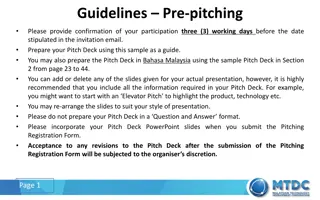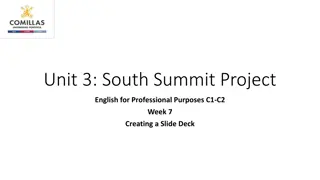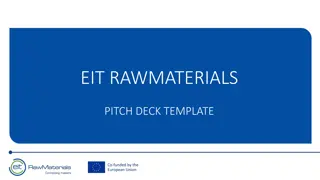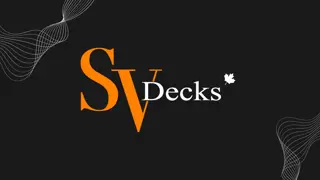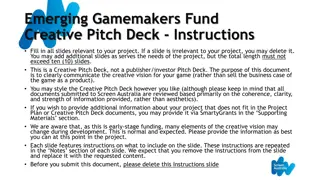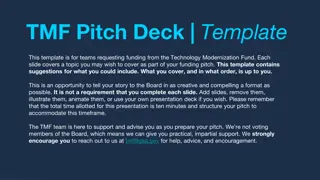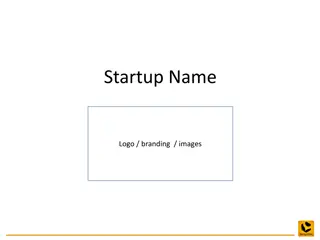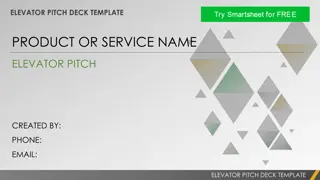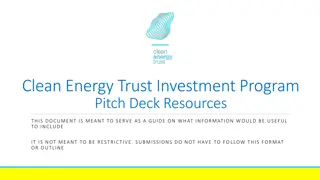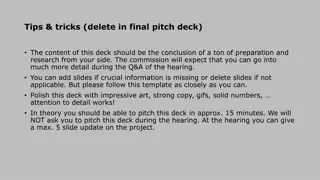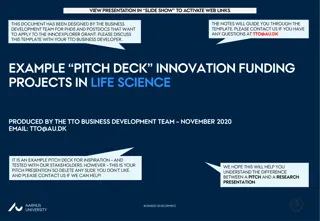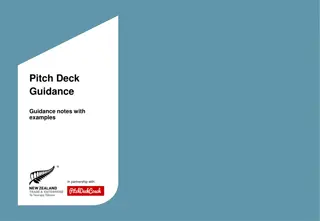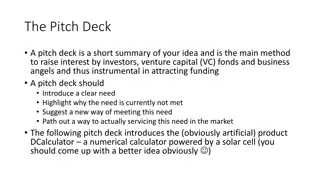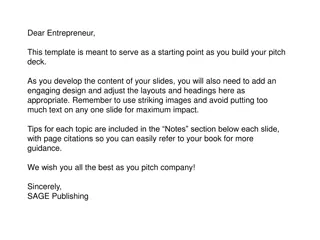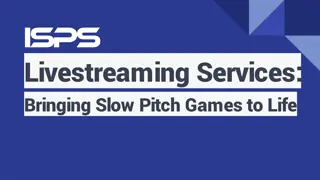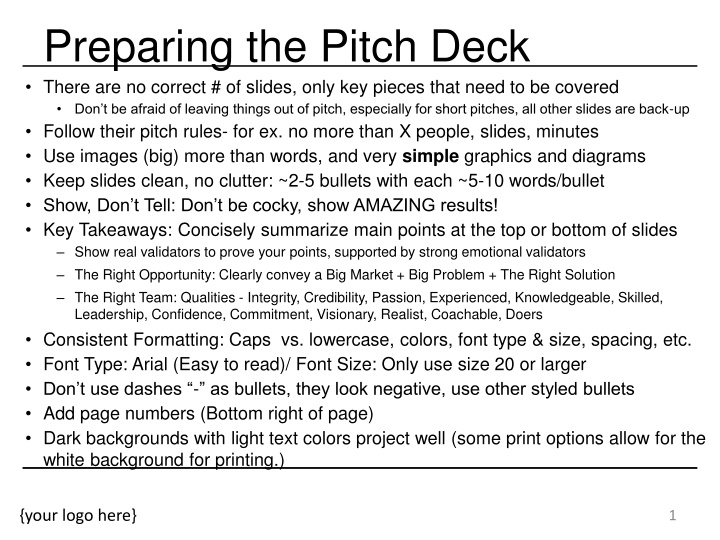
Effective Pitch Deck Preparation
Learn how to create a compelling pitch deck that grabs investors' attention, with key tips on content, design, and delivery. Follow a structured outline and nail your pitch presentation to secure investments for your business.
Download Presentation

Please find below an Image/Link to download the presentation.
The content on the website is provided AS IS for your information and personal use only. It may not be sold, licensed, or shared on other websites without obtaining consent from the author. If you encounter any issues during the download, it is possible that the publisher has removed the file from their server.
You are allowed to download the files provided on this website for personal or commercial use, subject to the condition that they are used lawfully. All files are the property of their respective owners.
The content on the website is provided AS IS for your information and personal use only. It may not be sold, licensed, or shared on other websites without obtaining consent from the author.
E N D
Presentation Transcript
Preparing the Pitch Deck There are no correct # of slides, only key pieces that need to be covered Don t be afraid of leaving things out of pitch, especially for short pitches, all other slides are back-up Follow their pitch rules- for ex. no more than X people, slides, minutes Use images (big) more than words, and very simple graphics and diagrams Keep slides clean, no clutter: ~2-5 bullets with each ~5-10 words/bullet Show, Don t Tell: Don t be cocky, show AMAZING results! Key Takeaways: Concisely summarize main points at the top or bottom of slides Show real validators to prove your points, supported by strong emotional validators The Right Opportunity: Clearly convey a Big Market + Big Problem + The Right Solution The Right Team: Qualities - Integrity, Credibility, Passion, Experienced, Knowledgeable, Skilled, Leadership, Confidence, Commitment, Visionary, Realist, Coachable, Doers Consistent Formatting: Caps vs. lowercase, colors, font type & size, spacing, etc. Font Type: Arial (Easy to read)/ Font Size: Only use size 20 or larger Don t use dashes - as bullets, they look negative, use other styled bullets Add page numbers (Bottom right of page) Dark backgrounds with light text colors project well (some print options allow for the white background for printing.) {your logo here} 1
How to Pitch Effectively Open by saying your name, title/role, and company name (Allows audience to get familiar with your voice before you start pitching, and it s just polite!) The Quick Hook: Grab the emotional attention of the audience within the first 1 minute, or take the audience with you on a STORY Team: Likewise tell the personal story of why you are invested in this company, and say what is relevant about each team member in the company. Use pictures of team if older/shows experience. Pitch your vision, not just what you currently have or are Reference things people know / understand, don t make people think or question you One Joke: Make audience laugh at least once, but don t do a comedy routine <10 min presentations Only one person presents, the CEO who can sell Don t read slides or stare at projector screen! Look forward / connect with your audience Don t speak too fast, people listen better when you speak slower and you sound wiser! Don t use industry acronyms / terminology, or reference companies they won t know Don t show a video, do show a quick DEMO or screen shots (pictures fail less often) If you run out of time, learn to skip to the end and the ask your purpose for being there {your logo here} 2
The Best Investor Pitch Deck Outline 0) Cover Slide 1) Elevator Pitch Slide 2) Team (If not impressive, move slide to after Your Solution to show who built it and why) 3) Board Members & advisors & Future Hires (Optional, combine w/ team slide) 4) Market Opportunity: Define Market, Size & Target Customer 5) Market Problem & Current Solutions: What need do you fill? 6) Your Solution (1-5 slides) 7) Traction & Awards (Optional, if none yet. Can be right after Elevator if impressive) 8) Market Fit / Competition (Optional, can be explained in slides 5 & 6) 9) Competitive Advantages (Optional, can be explained in slides 5 & 6) 10) Business Model: Key Revenue Streams 11) Market Approach & Strategy: Key Expenses / Time-Efforts / How you grow 12) Financial Projections 13) Exit Strategy (Optional) 14) The Ask: Capital Raise / $ Uses / Intros 15) Closing Slide: Questions? Contact Details 5 Slide Deck: 4, 5, 6, 2, combine: 10, 12, & 14 10 Slide Deck: Don t include optional slides 15-25 Slide Deck: Slides 1-15 + add l slides: Market Size vs. Target Client, Your Solution (1-5), Traction (1-3), Market Fit vs. Competition, Marketing Approach vs. Business Strategy, $ Raise vs. $ Uses {your logo here} 3
Cover Slide Logo / Name of Company Purpose of Presentation: Investor Presentation Date: Optional - if you send a deck with an old date, you look outdated (is it taking you a while to raise the round?). We recommend never using a date also people know today s date Other Potential Additions: Logos of accelerator, awards, publications featuring company Slogan Name of Presenter / CEO {your logo here} 4
Elevator Pitch Slide Create a brief one liner that describes: Short and memorable What s the core problem (describe pain) in the marketplace and the solution you re providing? What s your vision? Ultimate solution/business/service for customers/users? Graphically show this if possible Try: making it relatable as in We are X for Y ( We are Airbnb for Event Spaces ) ( We are the Starbucks of Frozen Yogurt ) {your logo here} 5
Market Problem / Current Solutions Big Market Problem? Big Un-met Need? You can t create demand (only market leaders can) Current Solutions = Current Problems? Biggest competition = Status quo, changing customer behavior, even if old systems are inferior, they exist everywhere, you don t Clearly show the pain of the problem or convey the strong desire that is being unfilled, don t just say it Solve your clients' number-one problem, Cyrus Massoumi, CEO of ZocDoc. Not their 4th or 10th problem. What keeps them up at night or really bothers them? Conclusion: The market has evolved and the current solutions don t fulfill/solve the clients current BIG needs/problems. There is a BIG opportunity here! {your logo here} 6
Market Opportunity What is the General Market Focus? Name it. Size it: Units / Revenue? Growth? What is the Total Addressable Market What s Your Target Market? The sub-sector of the General Market? Name it. Size it: Units / Revenue? Growth? Define Target Client? Key characteristics? Ex. Small vs. Large businesses, independents vs. agencies, examples of ideal clients or individuals Clients Current Needs? Describe any important market evolutions or trends and why we re at an inflection point now {your logo here} 7
Your Solution / Demo Show > Tell: ~1-5 slides of your product / service Show a live demo when presenting or show screenshots of key parts (Have screenshots within presentation prepared anyway, demos love to fail) Don t show a video, it can fail to play and takes away from your precious time Tell a story: Future client or an example of current client Show core value proposition to client Better, Faster, Cheaper (More Economical) {your logo here} 8
Market Fit / Competition Show how you fit into the Market Landscape Your advantages? Indirect Competitors vs. Direct Competitors? Your biggest competitor is the status quo! Why will customers switch to you vs. the incumbent? Are you changing customer behavior? Types of Diagrams/Charts: Market Landscape Comparison Feature List Comparison Pitch why you re 10x better, not just 3x better! {your logo here} 9
Market Landscape (Example 2) Your Logo Co. A Your Logo High Co. A Quality Quality Co. D Co. D Low Co. B Co. C Co. B Co. C Expensive Discounted Economical Economical {your logo here} 10
Competitive Advantages Current Competitive Advantages? Sustainable Competitive Advantages? Unfair Competitive Advantages? Patents? (Status, International?) Key Relationships / Partnerships? Barriers to Entry for New Players? Money, Time, Expertise, Relationships, Patents Competitor s Competitive Advantages / Weaknesses? {your logo here} 11
Revenue Model How do you make money? Key revenue streams? Pricing? Flat fee or %? Why that rate? Recurring Revenue Frequency? Is there a big difference between Gross vs. Net Revenue? High Volume vs. Low Volume Business? Example showing basic math: 100 Clients x A Units x B Fee = $C Revenue Easy to apply multiples: 10x, 100x clients Cash collections: Immediately? 30-90 Days? Expected conversion rate to get a paid client? Expected ARPU (Average Revenue Per User)? Life-time Value of Customer? {your logo here} 12
Traction / Performance / Awards Timeline / Key Milestones See, other people think we re awesome! Accelerator programs (we graduated!) Awards: #1 Best Startup / # 1 Best DEMO Lots of articles about us: TechCrunch / Forbes / CNN / FOX We re growing fast! We ve got lots of clients/users, some are brand name clients, look at our monthly growth, and we have a growing pipeline that will generate lots of $ We re performing amazingly for clients, look at these results! Customer success stories/testimonials See our key business metrics, we re doing great! {your logo here} 13
Exit Strategy Acquisition: Most likely exit option for companies Name potential companies (any unique relationships with them?) Name types / categories of companies that could acquire you Why would they acquire you, how do you fit into their strategy? Why won t they try to build it themselves? Financial Buyer: Will your company generate excess cash flow that could make it attractive to financial buyers to generate a return? IPO: The least likely exit for a company, but a possibility. Often not preferred to founders or investors compared to top two choices, due to required holding period and volatility, etc. {your logo here} 14
Team (if not strong, move to later) Core Team: The Founders & Chiefs that are critical to success Show a well-rounded team, technical AND business- if you are lacking in an area, show advisors Photos (Optional- Don t put in if mostly students) Relevant Experiences / Successes (Exits?) / Failures (Good war stories?) Leadership Experience/ Education whichever is impressive Don t write sentences, do 1-3 brief bullets per person, or even better do 1 key bullet per person We are the right team who can execute this business plan because... {your logo here} 15
Capital Raise / Use of Proceeds The Ask: How much are you raising and with what general terms (equity, debt, Convertible Note) and the timing Capital Raise: Stage / Size? Ex. Seed Round: up to $500K, Series A: $2-3M Investment Terms: Ex: Pre-Money Valuation Expectations / Range, Discount into next round?, Valuation Cap?, Dividend / Interest Rate?, Liquidation Preferences? Current Investors in Round: Founders, Key Angels, VCs Monthly Burn Rate? / How long will new $ last (runway)? Prior Investment Rounds: Size? Investors? Valuation? Key Terms? Use of Proceeds: (Name It / $ Amount / % of Capital Raised) How much raised? From whom? Sales & Marketing Hire key employees Founders salaries (Don t be greedy!!!) Build out / further develop technology File patents Achieve Milestones: 1st Client? Get to Breakeven? 3x Rev Growth? {your logo here} 16
Closing Slide Your Logo (Big & in Middle) / Link to site Any Questions? Contact Info: Name / E-mail / Phone After all questions have been asked by the investor, ask What s the next step in the process? Remember: Goal of Meeting = Get the Next Meeting {your logo here} 17
Back Up {your logo here} 18
Feature List Comparison Company Feature 1 Feature 2 Feature 3 Feature 4 Feature 5 Feature 6 Feature 7 Total Your Company Competitor A Competitor B Competitor C Competitor D Competitor E Indirect Competitor A Indirect Competitor B Indirect Competitor C Indirect Competitor D Indirect Competitor E This often makes you look 2-3x better, not 10x, so maybe only have as an appendix slide 7 4 4 3 2 2 2 3 3 3 3 {your logo here} 19
Board / Advisors / Future Hires Board of Directors? (Startups shouldn t have BODs! Wait until after Series A round to establish a board) Board of Advisors? (Give 0.1%-1% to advisors, no more!) What s their relevancy / support, other than big names? Are they investing? Big points if Yes ! If No , be careful. Your big fancy advisors will go from being a positive to a negative. If they are successful and have capital, they should invest, otherwise it shows lack of real support. Have a good reason for why not if asked. Reference key holes in management or operations that need to be filled (intros needed?) Few companies have the perfect team from the start, recognize that and solve it {your logo here} 20
Expense Model (Marketing / Strategy) Key Expenses / Time-Efforts Needed To Generate Revenue? Channels: How to reach / market to customers? Strategy: How to convert, acquire or close clients? Unique Strategic Relationships / Partnerships? Potential for leverage or scalability to grow fast economically? How long is sales cycle to get a client? Average Cost to Acquire a Customer? Cost to Maintain a Customer & Build Recurring Sales? Monthly burn rate, now vs. after funding? {your logo here} 21
Financial Projections # Years Projected: Startups: 6 year projections (accounts for ~1 yr of getting started) Early-mid stage: 1-2 year historical, 3-5 year projections Target Market Size vs. Acquired Clients: Total # Clients in Target Market (Show each year with growth) # Free Users vs. # Active Revenue Generating Users (shows conversion rate) % Penetrated (shows entrepreneur s sanity: growing from 0% to 1%- 5% penetration is usually sane, 50%-100% is usually insanity) High Level Financials: Revenue, Expenses, EBITDA, EBITDA Margin % Optional: Break out key revenue streams or Gross vs. Net Revenue Optional: Break out key expenses (Ex. # Employees) {your logo here} 22
Potential Appendix Slides Timeline: History, Milestones & Prior Funding Detailed Value Proposition to Clients / Users / Partners Detailed Financials: Revenue and expense breakdown, showing % of total revenue / expenses Average Revenue Per User (ARPU)? Per Client Size? Life-time Value of Customer (Churn Rate?) vs. Cost to Acquire Customer Breakeven Analysis: Base-case vs. Bare-bones case. # Clients / $ Revenue needed? Pipeline of potential clients, % likelihood of closing, revenue potential from pipeline Partnership Agreements / Structures Proprietary aspects not discussed in core deck Additional Strategy Slides: Ex. Architecture, How to avoid/limit circumvention, Funnel system of business operations, Growth strategy Capital Structure: Ownership of founders & current investors Competitors Capital Raises / Investors Head Count (# Employees) Projections / Key Hires Needed Additional Screen Shots from Demo Summary Slide: Why We ll Be Successful (Add if deck > 15 slides, otherwise too redundant) {your logo here} 23
Financial Projections By year 5: Revenue = $30-50M+, EBITDA = $10M+ Investors look for exits of 6-12x+ EBITDA = $100M+ Sale of Company EBITDA margins usually range 10%-40% Look up public companies in your industry or reports to see what is normal {your logo here} 24
Market Landscape (Example 1) Industry Segment 1 Indirect Competitor Logos Direct Competitor Logos Direct Competitor Logos Competitor Logos Indirect Competitor Logos Indirect Competitor Logos Industry Segment 2 Industry Segment 3 Your Logo Direct Competitor Logos Competitor Logos Direct Competitor Logos Indirect Competitor Logos Industry Segment 4 {your logo here} 25
Before The Pitch Get introduced to an Angel or VC, they don t respond well to random calls/e-mails Review portfolio companies of Angels / VCs before sending them your investor deck Investors don t invest in companies that compete directly with a portfolio company (shocking!) If there are strategic companies in their portfolio, they can make introductions to them even if they don t invest, such as potential clients, strategic partners, future acquirers, etc. Review investment criteria of Angels / VCs before sending investor deck Make sure you fit their industry focus (ex. Energy) or business type focus (Ex. B2B / B2C) Check the size of capital they invest ($250K? $1M? $3M+), the company stage (Startup/Early Stage/Growth Stage, etc.), or required financial metrics (Ex. Min of $1M in Revenue or EBITDA) Review investor backgrounds to find useful overlaps or who best to speak with at fund Practice, Practice, Practice! Nail down flow, slide transitions, timing, clarity of concepts, key mental frameworks, stories, answers to likely questions, etc. Arrival: Arrive 10 minutes early to set up computer, projector, get access to Wi-Fi, etc. Attire: Business casual is usually fine, but in doubt, wear a suit or ask them Ask the investors to provide a quick background on themselves and the fund ONLY if there s time. (You may just learn something and people love talking about themselves!) Can also ask who will be at the meeting (your audience) so you know their technical level {your logo here} 26
Handouts and After Pitch Prepare various presentations (PDF s) using 1 PPT file with all core slides and appendix slides 1) 1st Meeting PDF: Send Core Slide Deck (No Appendix Slides), when presenting use PPT so you can access appendix slides during Q&A if needed 2) Follow-up Meeting PDF: Additional slides (they may have requested you to create) and some appendix slides 3) Full Due Diligence PDF: All slides and all appendix slides (possibly requiring NDA) (This is usually once they have drafted a term sheet) Deck should be clear enough to explain itself and not need you When presenting, have add linsight to share on each slide = Your added value They often use the pitch deck now as a standalone business plan Afterwards, don t forget to follow up and get feedback. Don t just keep reusing the same pitch deck- revise it based on their feedback. {your logo here} 27
Top Investor Questions Company Questions: What s the history of the company? When did you start operating? Why did you create this company? How did you meet/find your team members? Why are you / team right people to execute this business? Target market size? Minimum market penetration needed for success? What s your traction? (MVP done?, user/revenue growth?, key milestones?) Why will you fail? Biggest challenges? Why will you succeed? Unfair / sustainable advantages? Show how you achieve the magic ratio: ARPU / Life-time Value > Cost to Acquire / Maintain a Customer Capital Raising Questions: What s the capital raising history of the company? How much / what terms? When did you start raising this round? What investors have committed? Have you invested any of your own money? Are your advisors investing? What s your valuation? Terms? How much cash is in the bank? What s your monthly burn rate (expenses not covered by operating cash flow from revenues)? = Runway (Cash / Burn Rate) Use of proceeds and expected results/milestones? {your logo here} 28
Words of Wisdom Be 10x better (at one thing vs. doing 10x more things), Being 2-3x better isn t good enough Focus on your customers #1 problem, not 10th problem Prepare yourself for rejection, ask why and learn There are lots of great ideas, but few can execute them Time is your biggest enemy! Build quick and cheap, and iterate, iterate, iterate pivot when needed Biggest Competition: Companies with equally great ideas and teams, but more traction at your stage Best Opportunity: A big growing market, with a big problem, and a simple solution (not overly complicated) You don t know, the market does! Ask often. {your logo here} 29

